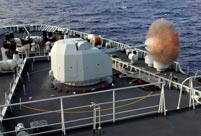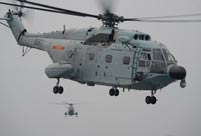 Turnip sculptures amaze tourists in Qingdao
Turnip sculptures amaze tourists in Qingdao Chinese ship formation conducts live fire training in West Pacific
Chinese ship formation conducts live fire training in West Pacific
 China comes in third at figure skating team event
China comes in third at figure skating team event
 China's teenager skater Yan shines at his Olympic debut
China's teenager skater Yan shines at his Olympic debut
 Taiwan-born actor stars on US TV series
Taiwan-born actor stars on US TV series
 Chinese Lunar New Year gift from abroad
Chinese Lunar New Year gift from abroad Chinese champions of Winter Olympic Games
Chinese champions of Winter Olympic Games  Zhang Yimou fined 7.48 mln for over-production
Zhang Yimou fined 7.48 mln for over-production
 Top 10 timeless female Chinese stars
Top 10 timeless female Chinese stars
The reforms involve various authorities and parties. The Civil Aviation Administration is not the main agency behind the reforms as airspace control primarily falls within the authority of the military.
"It takes time to move ahead with the reforms," Yang said.
Yang also identified general aviation as one of the still nascent industries with great potentials in outlining the strategic plans for China's aviation sector.
The strategic goal is for China to achieve an air transport passenger traffic of 1.5 billion per annum by 2030, which is set to make it the largest domestic air transport market in the world. By 2020, the annual turnover of the air transport system in China is expected to hit 140 billion ton kilometers. The population will on average make 0.47 trip per person per year, and there will be 260 airports, making air transport services available to 89 percent of the population.
However, Yang acknowledged that there are still bottlenecks such as infrastructure to the growth of the air transport sector in China.
The supply of air transport services will continue to be stretched over a certain period of time to come, as it can be seen from the on-time rate of the flight services falling in recent years and to as low as 71.8 percent in the first half of 2013.
This is in comparison with the 85 percent target on-time rate for flights in 2030.
Yang said the authorities in China will seek to expand the pilot reforms in low altitude airspace management, speed up the legislation works, simply the procedures for the general aviation aircraft and equipment to be approved, give more support to the general aviation specifically for use in charities and give more support to training.
Stanley Hui, chief executive of Hong Kong Airport Authority, said that the approach of allowing airspace to be primarily utilized for civil aviation but with exceptions if it is necessary may be an option authorities should consider.
Yang said there are still many preparatory work to be done to push through the reforms in low altitude airspace, including the capabilities and capacity building in managing the airspace under the new system.
"At the end of the day, the airspace resources should be utilized primarily to drive economic growth at peaceful times," he said, adding that infrastructure, capacity building and training will be necessary before the general aviation industry can really take off.

 Highlights of opening ceremony of Sochi 2014 Winter Olympic Games
Highlights of opening ceremony of Sochi 2014 Winter Olympic Games Highlights of Chinese New Year celebrations around the world
Highlights of Chinese New Year celebrations around the world  Chinese ship formation conducts live fire training in West Pacific
Chinese ship formation conducts live fire training in West Pacific Sanya bans skinny dipping in public beach
Sanya bans skinny dipping in public beach Top 20 most beautiful Chinese stars
Top 20 most beautiful Chinese stars  PLA navy conducts landing drills in South China Sea
PLA navy conducts landing drills in South China Sea  Snowscape in Chinese New Year
Snowscape in Chinese New Year Top 10 timeless female Chinese stars
Top 10 timeless female Chinese stars Top 10 Chinese films in 2013
Top 10 Chinese films in 2013 New Year greetings from Chinese nationals in Africa
New Year greetings from Chinese nationals in Africa Miss Chinese Int'l Pageant 2014 held in Hong Kong
Miss Chinese Int'l Pageant 2014 held in Hong Kong Severe coldness freezes large parts of China
Severe coldness freezes large parts of China  Beautiful moments of Sochi
Beautiful moments of Sochi  It's not just performing this year
It's not just performing this year Selfies of "Little colorful flag" girl unveiled
Selfies of "Little colorful flag" girl unveiled Day|Week|Month